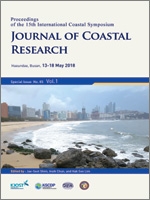Rehman, K.; Park, K.-Y., and Cho, Y.-S., 2018. Experimental and Numerical Investigation of Solitary Wave Run-up Reduction. In: Shim, J.-S.; Chun, I., and Lim, H.S. (eds.), Proceedings from the International Coastal Symposium (ICS) 2018 (Busan, Republic of Korea). Journal of Coastal Research, Special Issue No. 85, pp. 1111–1115. Coconut Creek (Florida), ISSN 0749-0208.
Rising sea-levels and extreme wave events threaten coastal communities and stability of coastal regions. Accurate prediction of wave over-topping over coastal protection structures is challenging, but vital for effective hazard mitigation. Non-hydrostatic numerical modelling and laboratory experiments are used to assess magnitude of run-up over coastal protection structures under varying relative wave heights and structural features. The primary focus is the investigation of solitary wave impact with breakwaters, the consequent run-up and measures for its reduction. The experiments consisted of generating solitary waves in a 1.1 m high and 32.5 m long flume and observing its run-up for different heights of incident waves. A slope adjuster was used to vary the slope of a plywood plank for reproducing coastal features. Experimental observations were verified by proposing a numerical model based on non-linear shallow water equations (NLSWE) and solution is obtained by Godunov-type finite volume method. The NLSWE provide good approximation of shoaling, wave breaking, and wave reflection which arise due to wave overtopping in the swash and surf zones. The novel feature of the numerical model is the introduction of bed slope discretization technique – applicable on both structure and unstructured meshes- which offers well-balanced solution even for steep slopes encountered in case of breakwaters. Shock-capturing capabilities of Harten, Lax, and van Leer with contact wave restoration (HLLC) solver are utilized for accurate estimation of shocks and bore waves features during flow transitions. The proposed model gives excellentn agreement with experimental observations. The findings will further enhance the understanding of extreme wave propagation events over submerged coastal structures and related mitigation techniques.





